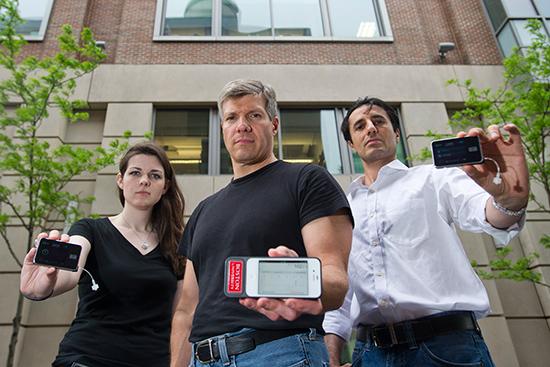Tonight’s University Lecture: Creating a Bridge to a Cure for Diabetes
ENG’s Ed Damiano to discuss his bionic pancreas

Ed Damiano (center), with research assistant Firas El-Khatib (right) and research fellow Catherine McKeon, says a cure for type 1 diabetes is perhaps two decades away. Photo by Cydney Scott
Is there anything more to be said about the bionic pancreas-in-progress codeveloped by Ed Damiano and Firas El-Khatib, which has been the subject of worldwide media coverage?
Actually, yes. “We’re collecting human data right now,” says Damiano. “There are nine experiments going on right as we speak. They’re based out at UMass Medical Center in Worcester, but we’ll be moving back to Massachusetts General Hospital and collecting another six more subjects’ worth of data over the month of November. And then we’re going to go out to Stanford in January and February and collect more data from 10 more subjects, and then the University of North Carolina. We just keep gathering more data.”
Damiano, a College of Engineering associate professor of biomedical engineering, will discuss his research and personal motivation for combating type 1 diabetes when he delivers the annual University Lecture tonight at the Tsai Performance Center.
His bionic pancreas would regulate glucose levels in diabetes patients, even when they sleep, averting the nerve-fraying nocturnal checks on a child’s blood sugar levels that Damiano and other parents of type 1 diabetes patients are all too familiar with. His 15-year-old son, David, was diagnosed with the autoimmune disease when he was just 11 months old. Damiano says he was driven to invent the device out of fear that his son could die if his blood sugar level fell while sleeping (so-called dead-in-bed syndrome).
He’s expecting a largely lay audience for his lecture, A Bionic Pancreas for Type 1 Diabetes: The Long-Awaited Alternative to the Ever-Elusive Cure, so he’ll explain “what it is that diabetes is, what it’s like to live with, and what the challenges are, what the fears are.” He’ll tie his research to his “personal drive to get this done” for his son while outlining the technological capabilities of his bionic pancreas, which he says will be a bridge to a final cure for diabetes.
The device consists of a glucose monitor and two pumps—one for insulin and another for glucagon—as well as an iPhone that runs the algorithm that computes how much insulin or glucagon to administer.
“It’s not as good as a cure, but it’s the next best thing, and it’s something that is within our reach.…I don’t see a cure in 10 years. I see a cure maybe in 20,” Damiano says, citing the state of research and the years-long process of clinical trials. Meanwhile, his bionic pancreas has been tested in dozens of adults and children in a series of inpatient and outpatient trials, and he hopes it will be available in three years.
The University Lecture dates back to 1950 and gives faculty doing outstanding research the chance to discuss their work with the public. The lecturer is chosen by the preceding five years’ lecturers from among nominations by BU’s faculty.
Ed Damiano’s University Lecture, A Bionic Pancreas for Type 1 Diabetes: The Long-Awaited Alternative to the Ever-Elusive Cure, is tonight, Wednesday, November 12, at 7 p.m. at the Tsai Performance Center, 685 Commonwealth Ave. Admission is free and open to the public.
Comments & Discussion
Boston University moderates comments to facilitate an informed, substantive, civil conversation. Abusive, profane, self-promotional, misleading, incoherent or off-topic comments will be rejected. Moderators are staffed during regular business hours (EST) and can only accept comments written in English. Statistics or facts must include a citation or a link to the citation.